
Arch
443/646: Architecture and Film
Fall 2004
The Fifth Element (1997)
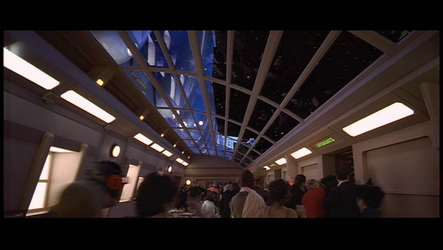
 |
Arch
443/646: Architecture and Film The Fifth Element (1997) |
 |
Discussion
Questions:
|
The film The Fifth Element is the most recently executed of the films we are looking at this term. It has had the benefit of great advances in film making technology, as well as the ability to use precedents as they have been developed in many of the previous science fiction and dystopic films. This film is also the most highly reliant on computer animation and the generation of complex urban scenes and settings via this method. The shift to "bright light levels", versus the somber, rainy mood of Blade Runner, also puts the graphics to the test. Unlike films that are set "on location", computer and animated films are all purposefully done. Everything is deliberate and everything takes an extreme amount of effort. When creating your paragraph for your image set, please make direct comparative references to at least one of the previous films of the term. YOUR IMAGES ARE THE ONES BELOW YOUR NAME. |
| 1. Michael Votruba : Vertical movement in the city | x | |
Comparing transportation within Fifth Element and Fritz Lang’s 1926 version of Metropolis shows the progression of the modern city. In Metropolis a look into the future included vehicles held in constant gridlock on enormous highway overpasses. This is reality in the present-day city where rush hour traffic has increased to an unsustainable level. Fifth Element looks beyond typical traffic conditions and portrays a a Manhattan traffic pattern that is multileveled. Traffic flow is no longer limited by rotating tires on asphalt surfaces because automobiles have the ability to fly. The second of the images below, shows the character Leelo ( Milla Jovowich) falling. In this sequence vertical movement becomes the means for escape. Gravity still pulls downward working to her advantage. Leelo ends up crashing into the roof of Major Korben Dallas’ (Bruce Willis) roof. Leelo’s will to avoid capture signals this outstanding stunt. Dallas is traveling horizontally along with the typical grid of city traffic and saves the life of this mysterious anomaly. Her fall into his roof is abrupt and unexpected. It becomes Dallas’ fate to help Leelo save the earth. Vertical
movement in the Fifth Element reveals an interesting look into the future
of transportation within the city. In the futuristic depiction of Manhattan
there seems to be a continuation of the grid that exists in the present-day
city. Fifth Element’s transportation grid operates on an infinite
number of levels because cars can fly while maintaining their same functionality
that they have on the ground. Vertical movement between these levels seems
to occur for the most part rather sparingly. In the images below the train
is one way to move up and down within the city. It is unlikely that this
train is used for carrying passengers because of the discomfort that would
be experienced. As a utility train it could be used to carry goods to
the upper layer of the city quite efficiently. Vertical transportation
and the multiplicity of layers creates a three dimensional matrix within
which transportation works more efficiently in serving future Manhattan.
The Fifth Element offers a convincing depiction of the necessity of moving
three dimensionally within the future city. |
||
| x |
2. Federica
Martella : Fhlotsan Paradise |
|
The spaceship
descends through some clouds and glides over a vast turquoise sea. This is how
the enormous cruise ship is described in the script of The 5th Element.
…Yesterday's
unknown will be tomorrow's Prince of Fhloston Paradise, Where a famous Diva comes to entertain the guests with her beautiful voice every ten years, where people are so extravagant and fancy (dressed with Jean-Paul Gaultier) and everything is so colorful and full of light (compared to the dark and rainy future of Blade Runner).
|
||
|
3. Olivia
Keung : The use of neon colour |
||
The role of neon lights and colour in The Fifth Element emphasize the contrast between the city portrayed here and other futuristic settings such as Blade Runner and Fritz Lang’s Metropolis. The latter movies depict dystopic cities that are dark and dreary. These cities are troubled places where the lights that represent the power of technology benefit an exclusive class of people; it is something reserved for those with power, who control the city, while the unfortunate classes whose labour actually makes this realm possible exist in an underworld shrouded in darkness. In Blade Runner, the neon lights of large-scale advertisements becomes an omnipotent presence that cannot be located, but that floats far above the city. In The Fifth Element, the city is free of the moral struggle involving technology and city-building; good and evil are abstract concepts that do not connect with specific spaces and people. Perhaps the New York that this movie depicts shares more with Zone 1 of Tezuka’s Metropolis: both cities are places of spectacle. Neon lights in The Fifth Element are everywhere: technology is a triumph; it services both good and evil; the city becomes a place of pleasure and brilliance. The rare instances where neon colour is actually isolated and specific deals with elements of the higher order of good and evil. It is a way of depicting this abstract and ethereal quality. It is a major element in the scene in which the stones are finally activates these mysterious forces. The diva scene is obviously reminiscent of Jean-Jacques Beineix’s Diva: here, the divine quality of music is visually emphasized in lighting and architectural space, where the audience forms a collective response to Hawkins, and also in the intimacy of Jules’ experience of music. In The Fifth Element, this divine presence is represented perhaps more literally with the use of neon colour. Both films portray music as something mysterious, that can’t be contained in human understanding. Perhaps the universality of neon colour in The Fifth Element is expressive of humanity’s efforts to mimic and control, or even simply to attain an understanding of this sense of the divine through technology.
|
||
|
4. Adriana De Angelis : The Portrayal of the Architecture at the "main" city level |
||
Eighty years separete the realization of Metropolis and the one of The fifth element, but the two films have somehow something still in common. Done by two European directors, the German Fritz Lang for the first and the French Luc Besson for the second, they speak about the future and about human fear of what lies ahead, fear of the unknown. Metropolis with its dramatic, almost apocalyptic way and The fifth element with its irony and lightness seem to be the beginning and the end of a discourse, almost hundred years long, about life in earth modern cities which, being somehow no more up-to-date, could in the near future eventually be transferred to life in cities on different planets. City in Metropolis have different levels representing the two distinct classes in which society is divided. In The fifth element equality seems to have finally been reached among humans since everybody lives at the top of the huge skyscrapers which do not scare anybody anymore. Human beings, and therefore architects, seem not at all interested in what lies at the bottom of the very tall buildings where only emptiness, darkness and discarted materials can be found. Only transportation, in order to avoid traffic jams, is organized on different hights, but still everything happens up in the sky and it is from sky that danger and rescue come. Even love, in the person of a charming red hair angel, comes from there and not from the catacombs like in Metropolis. The whole vision of things is completely different in the two films even though, surely one is derived from the other. In Metropolis the future is only scaring unless helped by love in The fifth element, once we know it, we can also play with what lies in front of us and our fears of it which become somehow ridiculous. Should it not be time for us to pass to other, major problems which concern much more and more directly our nowadays life and finally leave behind the debate on the modern city or at least to actualize it? |
||
| 5. Julia Farkas : of robots and aliens | ||
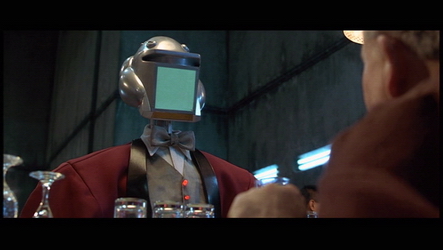 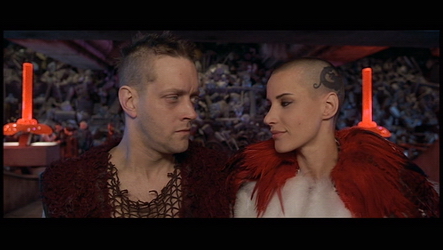 |
||
|
6. Francesco
Mancini : the role of the police/authority |
||
In the movie
“the Fifth Elementh”, the role of the police is reduced to
a grotesque show of impotence and lack of power control and crime prevention. |
||
|
7. Christian Tognela : eating and food |
||
|
Ingredients: Directions:
|
||
|
8. Nancy
Gibson : parking |
||
So parking
is hovering regular cars so they take up space vertically as well as horizontal.
Is that the best he can think of? If I were imagining a future of vehicles,
I would imagine people would make more use of the three dimensions they
were given, and not just for parking. I can imagine the thought process
of 3 dimensional drivers in the future and they wouldn’t pull in
like 2D drivers. If you were use to 3D driving, that is how you would
conceive of landing. Immelman turns, split S’s, spins and rolls
come to mind here. They’re a lot more efficient than driving down
the block and turning around 2D. I wonder how passengers get in and out
from the parking spaces though, since there aren’t any sidewalks.
This writer’s idea of vehicular traffic is as lame as his conception
that the Chinese of the future are still cooks, driving anachronistic
delivery restaurants in a New York that is still the centre of commerce.
Urban driving in “Just Imagine” was much better thought out.
At least it tried to suggest how things might work instead of relying
on appearances alone to convey the impression of the future. Fifth element
ends up looking like a comic book story. |
||
|
9. Clementine Chang : Travel through space -- the passage of time? |
||
In a number of movies we saw this term, representation of highly advanced transportation has been used to communicate futuristic urban visions. In Metropolis, Blade Runner and The Fifth Element, similar swarms of flying cars flood the city vertically and horizontally. These flying vehicles have evidently become the icon of future cities. Space travel is portrayed as an everyday common event in both Blade Runner and The Fifth Element. It is no longer something that’s exclusive to government research, but rather a commodity made available to everyone by the advent of technology. In Blade Runner, the human population is said to have gradually relocated themselves to other “off-world” planets in order to escape the devastating decay on planet earth. Meanwhile, in The Fifth Element, the idea of space travel is taken to the extreme. Here, the concept of space tourism is presented, making space travel not mere necessity, but luxurious desire. In the film, an orbiting hotel entertains thousands of tourists with fine dining and opera performances by an alien diva. The passage of time when traveling through space is deceivingly short in both Blade Runner and The Fifth Element. Although foreign planets are many unimaginable light years away, the audience is left with the impression that it takes no time to travel to outer space. It would seem that the situation is much the same as our present travels to other cities on our own planet. In the film, when Korben Dallas and Leeloo traveled to the orbit hotel, the passage of time is clearly compressed. They were forced to sleep by just the press of a button and awaken just as easily. This way the passengers of the rocket plane get the impression that the trip is a mere blink of an eye. It is also interesting to note that the coffin-sized sleeping cubicles on the rocket plane are reminiscent of actual capsule hotels in Japan.
|
||
| 10. Mark Cichy : the architectural manifestation of Zorg and its evil genius (notice how the view outside the window changes...) | ||
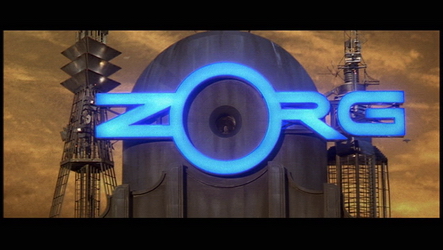 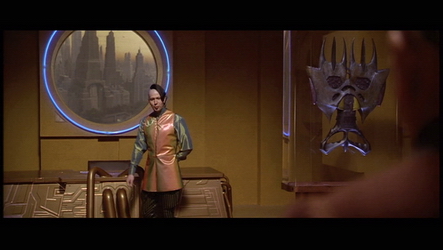 |
||
|
11. Aaron
Nelson : circular rooms and corridors (why?) |
||
The reason
for the circular rooms and corridors I believe relates back to the whole
theme of the movie, initially of what does the fifth element symbolize
and relating this theme though the visuals and architecture of the sets
and computer generated imagery. |
||
|
12. Elizabeth Myers : fashion |
||
The Fifth Element is the most recent film viewed in class. The advances in technology and film making are evident, and can be seen in the lighting, sets and special effects. It follows a common theme found in many of the films viewed this term, the future. It used many of the same elements as the other films when depicting the future, crowded cities, flying transportation, pollution, and space travel. However it seemed that this film pushed the limits more than others to incorporate aspects of the future throughout. A good example of this would be the fashion throughout the film. In many films previously viewed fashion is one of the few elements that remain somewhat current. Perhaps this was to not overwhelm the audience, or so that the audience could more easily relate to the characters. However, in The Fifth Element, fashion has no boundaries. It is portrayed as being completely over the top; very bright colours, wild hairdos, and very skimpy clothing. This could be a reflection of the fashion industry of the 90’s, which was constantly becoming more and more extreme, compared to the industry earlier in the century when the other films were made. Looking at Just Imagine for instance, the fashion in the film was representative of the time, with only slit moderation, as though they couldn’t imagine fashion changing all that much over time, compared to technology. However now the custom designers have seen how quickly fashion can change, and how extreme it can be. The fashion in the film completes the image of the future. Everything seen within the film is part of another world; the audience becomes transported to another time. |
||
|
13. Vivien Liu : the city of New York in 300 years time |
||
The world of Fifth Element, unlike that in Blade Runner, has remained the home of mankind despite the major advances in space technology which enables inter-galactic travel. Thus, Earth is not an abandoned and decaying relic of civilization but continues to develop into a hyper-speed society with intricate networks of hovering vehicles and soaring skyscrapers, like Lang’s Metropolis put fast forward. In the film there is a complete lack of scenes that take place on street level and the base of buildings are given less detail to emphasize the heights of the towers, indicating that life takes place at the level where vehicles hover. There are recognizable landmarks included in the movie such as Brooklyn Bridge (second image) although its function is clearly redundant. Like Blade Runner, there are no traces of nature but yet in the Fifth Element the skies are not polluted with industrial smog and sunlight still penetrates to illuminate the city. This adds to the film’s positive outlook of a somewhat less dystopic society (the President is still a human being). |
||
|
14. Joshua Bedard : common persons and intermediary spaces |
||
Since our
viewing of Fritz Lang’s Metropolis, we have seen the emergence of
the sci-fi film genre. One particular thing that these films (Metropolis,
Just Imagine, Blade Runner, Brazil and The Fifth Element) have in common
is that they are all centred on the average citizen and depict to us a
view of what the future may bring. While the directors of these films
set out to depict the city to us at a grand scale they also give particular
importance on the smaller details of the average citizen. This can be
seen in each films depiction of residence. |
||
|
15. Tammy Chau : the architecture of the paradise destination |
||
The paradise destination contrasts the underworld in every attempt. Once the crowd emerged from the spacecraft they were greeted by a group dressed in tribal costume, the atmosphere is forced with the presence of culture. Clearly, the underworld has been the victim of globalization and industrial standardization where traces of culture have became a rarity. The camera pans across the crowd and reveals the main hall with oval shaped windows. The bright blue sky is not only emphasized, but extends onto the blue décor of the room itself. All the spaces in the paradise destination are excessively decorated with gold trimmings and flamboyant furniture; one may easily relate such extravagant yet paper thin ‘architecture’ to Las Vegas. Every room seems too spacious and overly sterile, a contrast to the underworld. It becomes more obvious in Korben Dallas’s guestroom, where the ornaments and furnishing materials attempt to covey the gesture of an extravagant room, yet the way the overly sterile ‘marble’ floor reflects light only leads one to question how synthetic the material is. After all, the room resembles a hospital room more than a hotel room. |
||
|
16. Liam
Brown: state of the environment |
||
It seems a little bit suspect that a society that sits below perpetually blue skies would have no problems with pollution, and so it is no surprise that they have garbage flowing into airports and scattered underneath the expressways. It could almost be past off as intentional had not the ticket agent at the airport apologized for the mess. Instead, Luc Besson’s the Fifth Element addresses the environmental dystopia of the days to come. The glaring commentary on our nature as people to not consider the ramifications of our actions is paramount in the depiction of the state of the environment. In past films they do not address this, Metropolis deals with classes, Blade Runner with species, Alphaville with technology, but the Fifth Element strongly addresses the environmental dystopia of the future. The president who hastily makes the decision to blow up the great blob in outer space only strengthens it, while had he listened to the advice of those around him, then he would not have to deal with an even greater problem than the one he had initially been faced with. So too today do we conduct ourselves without the consideration of the consequence, and we pollute, waste and consume without the realization of the mess that we are in, and the mess that is getting stronger the more we hastily continue to live the way we are living. A problem is not much good without a solution and even in Besson’s examples there could be hope. The overflowing airport waste could be compacted and act as sound barriers for the loud traffic of planes. The multitude of colourful mess packed therein could be a lovely mosaic set behind glass, providing both function and aesthetic. The metals placed underneath the expressways; well they could act as conductors to the vehicular or train traffic, instead of a graveyard to household appliances past. The scenes in the Fifth Element depicting the state of their environment serves as a warning to the way of life of now, and its manifestation in the future. Luc Besson outlines the future dystopia that we may soon be facing, where no amount of creative solutions may be helpful. |
||
| 17. Matt Bolen : advances in technology | ||
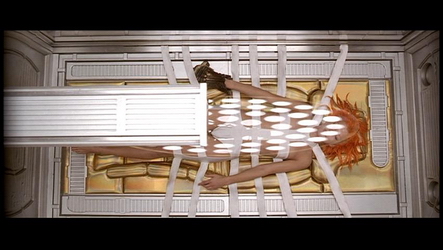 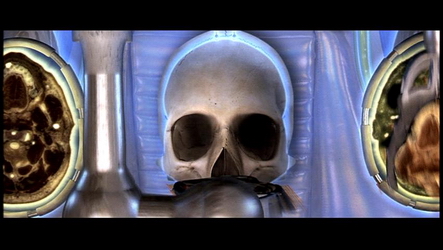 The following images of the “fifth element” being transformed from some kind of pod or seed into a human being show the development and advancement in technology that is depicted in this futuristic film. This prophecy on technological advancement is made using various precedent from films released over the past century. One of the first of its kind to make such prophecies was Fritz Lang’s, Metropolis. Lang’s film from the 1920’s made various prediction on technological advancement that would occur in upcoming decades. These mainly focused on telecommunication. The connection of this prediction to the one made in the Fifth Element is that they both comment on current “hot topics” which were being developed in the way of advancement at the time. At the time of Metropolis, large advancements were being made in the way of telecommunication with radio waves fully being examined. At the time when Fifth Element was made filmed a very hot topic in the way of technological advancement was cloning and genetic manipulation. This therefore manifests itself in this film as the current most outrageous prophecy for technological advancement precedent. Due to the development of computer animation at the time of this film this aspect of technological advancement was able to be fully and quite adequately explored. As seen from the images, the scene takes on a realism which the eye wants to fully believe. Because of this, this movie raises an interesting question: will the computer generated world which we experience in the movies ever transcend the imaginary realm of the film world and enter our everyday reality?……or has it already begun to do so? |
||
|
18. Andrea
Krejcik : The Diva |
||
In the film
Fifth Element there is a lot of focus placed on the character of, the
Diva. In many of the films studied in class, sound is perceived to be
the highest form of expression that anyone can convey. The best known
example is the representation in the film “The Diva”. There,
the opera singer’s voice is transcendent of any of the turmoil taking
place on Earth. The sound of her voice is in a way an escape from reality.
This seems to be a running theme through many of the futuristic films
seen this semester. |
||
|
19. Natalie Drago : architectural precedent |
||
In the fifth element, the year is 2259 and the world is under siege. The film is a slam dunk sci-fi extravaganza written and directed by Luc Bresson. It is also an extravaganza of architectural design, fashion design and hair design. It’s a highly constructed spectacle of light and setting propelled by a lively assortment of special effects, exotic sets and design and wild costumes. It features a wonderful cast of scenery eating villains who make the most out of this spectacle. The future New York scene depicted is brightly colored and its air traffic lanes look super cool as flying objects whirl by in the super imposed computer animations. It’s cyberpunk aesthetic and philosophy at its modern brightest best. The architectural precedence for this film was set and tested and experimented with in many ways, in many forms on many levels by a number of films we experienced in this course. The contradiction depicted here between modern contemporary architecture and traditional or futuristic design reminds us of the contradiction between the forms of architecture depicted in Blade Runner. Blade Runner architecture set some precedence for the creation of the Fifth Element set design. What of tradition vs. modernity? Here traditions is synonymous with elements of religion, love and faith while modernity or even futurism are synonymous with technology, evil, destruction and general mayhem. The cyberpunk element found in design avenues throughout the course of Fifth Element was also contained in Blade Runner as well as moments or the aura of a glooming oppressive atmosphere. Both films also touch on ornamentation and it’s place in design vs. industrial unornamented design. The more exotic components of design found in The Fifth Element setting and stage remind us of the pleasure garden design and manifestation founded in Metropolis. Both apply organic references and forms as well as working with tectonic derivations. In addition Just Imagine, in the alien world setting incorporated elements of exoticism in their set and costume design. In many ways all the three scenarios use exoticism to take us away from the banality and plain functional forms that have defined and dominated everyday architecture. Secondly all the aforementioned films and the Fifth Element cause us to consider clothing and hair in architectural terms, definitions, principals and conditions. They exist as terms with social implications, which therefore have meanings and serve a purpose as well as being manipulated tectonic forms with structure designed into their forms. We are in each scenario addressing and being presented with new ideas or shall we say variations of old ideas that date back to the beginnings of technology being conceived as a resource adopted into mainstream culture expanding building and design possibilities. All the aforementioned films address and work with the notions of technology and the theme of dystopic worlds. The Fifth Element being a kind of new age dystopia displaying a mixture of traditional, modern, futuristic and exotic breeds of architecture, encompassing all dimensions of design, design development and design characteristics. These forms of architecture are four elements contributing to the film atmosphere, again reminiscent and drawing from past films, developing film setting and environment. Something interesting I read: “Similarly the laws of gravity and light seem totally dissimilar. They obey different physical assumptions and different mathematics. Attempts to splice these two forces have always failed. However if we add one more dimension, a fifth dimension, to the previous four dimensions of space and time, then equations governing light and gravity appear to merge together like two pieces of a jigsaw puzzle. Light, in fact can be explained in the fifth dimension. In this way, we see the laws of light and gravity become simpler in five dimensions.” “Hope it helps the understanding of what the fifth element means, and all the time we are still speaking about energy here, not as an understanding of the aether, but of what that missing mass means.” Bibliography:
|
||
|
20. Shane
Czyphya : communication? |
||
In the dystopic
future state of the world in “The Fifth Element” telephone
communication is one of the only things that have not progressed from
today’s world. In fact, phones have almost regressed. There are
no cell phones, which is certainly a regression from today’s society
(although whether that really is regression or progress is debatable)
and there are not regularly used videophones, which are a commonplace
prediction in so many futuristic movies. The only advancement is the use
of the video doorbell, which addresses the issue of necessity and safety,
and is not really in any way frivolous. In this very built world there
is little to no privacy. The fact that there are no cell phones or videophones
comments on our necessity to resist technology in favour of privacy. This
is a step towards keeping control of the world in the hands of humans,
and not allowing our own conceived technology take over. This is unlike
Brazil and Blade Runner, where technology has gotten out of control and
life has become a struggle against our own inventions, the very technology
conceived to improve our quality of life. The way phones are treated in
the Fifth Element is a comment on the culturally responsible discretion
needed in the consideration of the role technology should play in our
lives. |
||
|
21. James
Arvai : the height/cross section of the city |
||
Cinematic
technology in the film The Fifth Element is used to great effect to suspend
disbelief of viewers. The new film technology presents a futuristic urban
imagery with a very high “shock and awe” factor. The new film
technology puts the viewer convincingly into the future by presenting
a world that resembles our own but is reshaped by futuristic technology.
Recognizable icons of our urban society are everywhere in the film. Examples
include the yellow cab (it flies in the future but the cabdrivers are
still characters), the cruise ship resort (it orbits a planet in the future)
and the always too small urban apartment of the working class (with everything
built-in space saving in the future). In previous futuristic films futuristic
technology is often at odds with humanity and is demonized. The urban
setting in futuristic films is often co joined with technology and its
demons. An Early example is the film Metropolis (1927), a recent example
is Blade Runner (1982). I believe the film The Fifth Element turns a corner
in SciFi vilifying technology. This film does not present technology as
the villain. The urban futurscape is engaging and often exiting. I love
it when everyone gets to have flying cars. The characters of the film
play out a human drama with the futuristic techno as a backdrop. |
||
|
22. Anne-Marie
Armstrong : The Opera House |
||
The Opera House in the film, Fifth Element can be immediately related to the film Diva, where in both circumstances the operatic experience is elevated beyond simply a performance to one verging on what could be considered a divine experience. In the film Diva, the Opera House is a crumbling, peeling space with a bare wall as backdrop. The setting here is unimportant, it is the performance which is punctuated and what generates the experience for the audience. The Opera House in the Fifth Element is set on a pleasure space machine. The interior is extremely lavish, and similar to most of the scenery of the movie, due to computer generated imagery has a certain shiny newness to it. The backdrop is, supposedly, natural and dramatic - it is the backdrop of starry constellations and planets. The senses are overwhelmed by the space and setting of the House, the action of the audience, the performance of the Diva. Which effectively build up to the point at which chaos ensues in the violent search for the four stones. Further to the relavance of the Opera House, the role of the Divas in both films can be contrasted. Where in Diva, we encounter Cynthia Hawkins, who as a Diva has a distinct personality and position from the rest of the cast of characters in the film, in The Fifth Element, the Diva character is literally a treasured creature. We first encounter the Diva shrouded in a cloak, surrounded by an entourage. She is only revealed during performance as a dramatic blue creature with an otherworldly voice. The audience is transfixed for a moment before the chaos ensues in the search for the stones. |
||